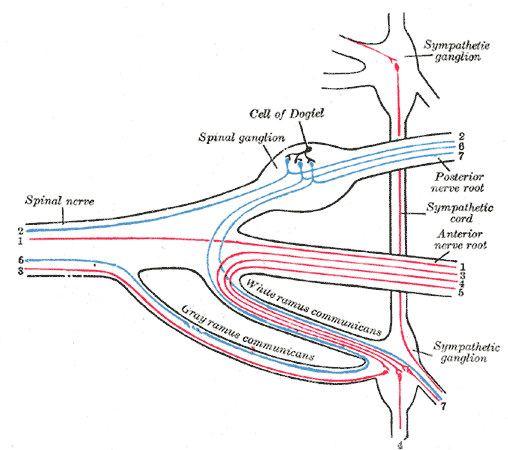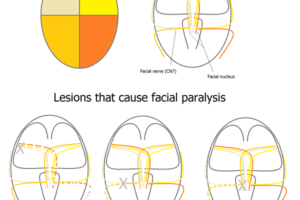
The anterolateral system carries pain and temperature information from the periphery to the VPL nucleus of the thalamus, and on up into the somatosensory cortex.
Peripheral Receptors
Pain receptors (called nociceptors) are “free nerve endings,” that is, there is no extra-cellular matrix capsule or epithelial cell receptor coupled to the neuron. These free nerve endings are effectively chemosensors, responding to cellular damage by detecting small molecules like ATP, bradykinin, prostaglandins, serotonin, protons (pH changes),and several other molecules released by injured cells.
In addition to initiating an action potential that propogates toward the spinal cord, the nociceptors amplify local inflammation by releasing a series of compounds to activate other local structures. For example, they release Substance P, which causes degranulation of local mast cells. They can also cause local vasodilation through the release of CGRP onto capillaries.
There are also temperature receptors – these will be covered in the section on the trigeminal nerve since these receptors, in addition to responding to different temperatures, are also sensitive to chemicals to which we often associate certain flavors (menthol and capsiacin).
Cell Bodies in Dorsal Root Ganglion

Just as the cell bodies of the DC-ML system sit in the dorsal root ganglion, so do the cell bodies of the anterolateral system. The endings of the anterolateral system are also distributed over dermatomes.
Synapse in Substantia Gelatinosa and Decussate
The DC-ML and anterolateral pathways diverge immediately upon entering the spinal cord. Fibers of the anterolateral system enter the spinal cord then can go up or down a few spinal levels in Lissauer’s tract. The axons then enter the dorsal horn and synapses within the Lamina II/III of the spinal cord gray matter. Lamina II/III in the dorsal horn is known as “substantia gelatinosa” and has a characteristic appearance that is also found in the spinal trigeminal nucleus.
The second-order fibers from the substantia gelatinosa decussate immediately and run rostrally in the tracts of the anterolateral system. At this point the spinal cord carries ipsilateral light touch, proprioception and vibration information, but contralateral pain and temperature information. Unilateral lesions of the spinal cord therefore produce contralateral pain and temperature deficits and ipsilateral touch, proprioception and vibratory sensory deficits.
Anterolateral Tracts to VPL in Thalamus
The anterolateral tracts run lateral and ventral through the spinal cord and most of the midbrain. The medial lemniscus joins the anterolateral tracts just before entering the thalamus. Both pathways synapse within the VPL of the thalamus.

